Organizational Behaviour Report: Sainsbury's Analysis and Strategy
VerifiedAdded on 2023/01/12
|11
|3336
|86
Report
AI Summary
This report provides an in-depth analysis of organizational behaviour within Sainsbury's, a major UK supermarket chain. It explores the influence of culture, politics, and power on individual and team behaviour, referencing Handy's cultural model and Hofstede's classification. The report examines strategies for motivating individuals and teams, including content and process theories of motivation such as Maslow's hierarchy of needs, Herzberg's two-factor theory, Locke's goal-setting theory, and Vroom's expectancy theory. Additionally, it discusses the importance of teamwork and cooperation, outlining different types of teams and their roles in enhancing organizational performance. The report emphasizes the significance of these factors in achieving Sainsbury's goals and maintaining its market position.
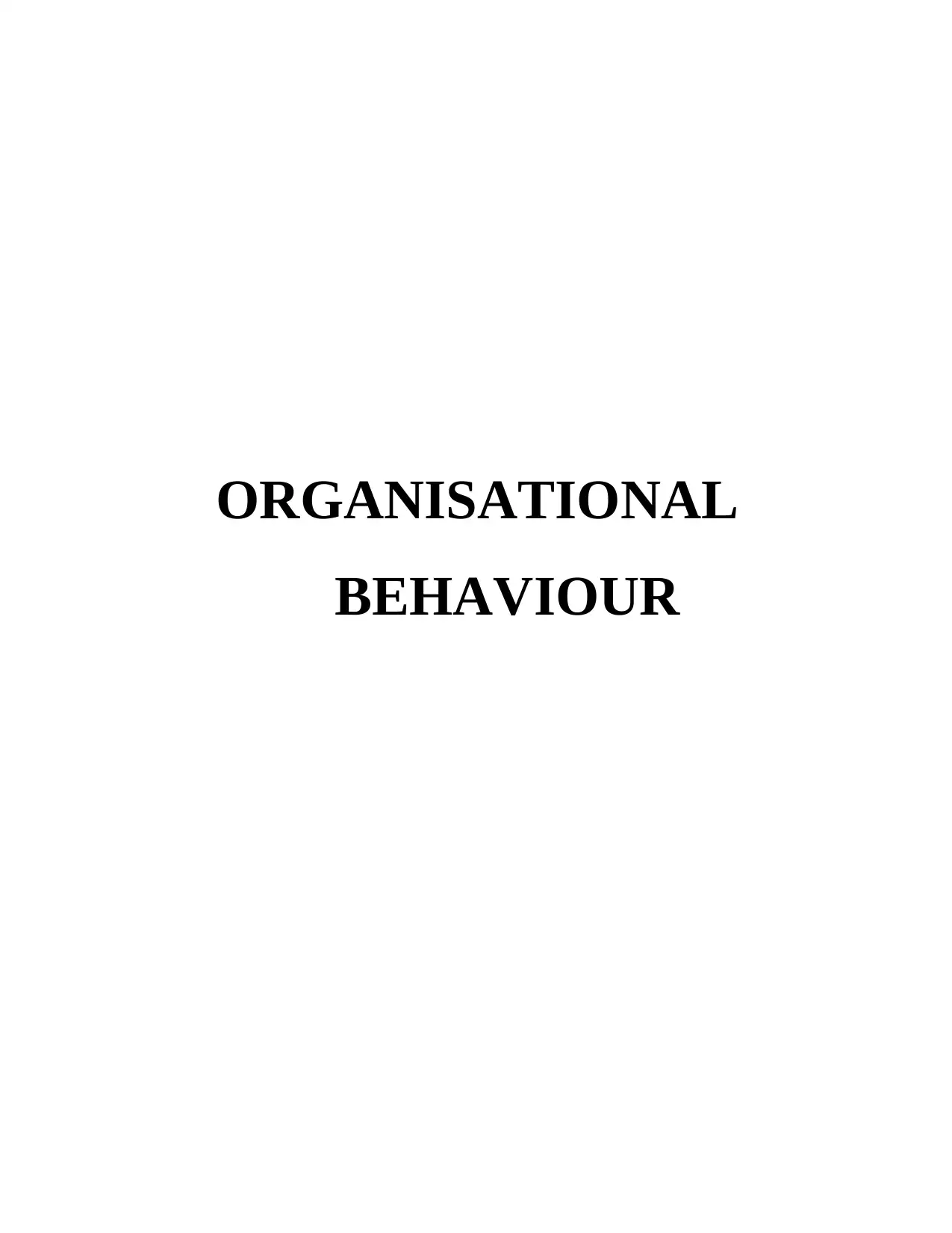
ORGANISATIONAL
BEHAVIOUR
BEHAVIOUR
Paraphrase This Document
Need a fresh take? Get an instant paraphrase of this document with our AI Paraphraser
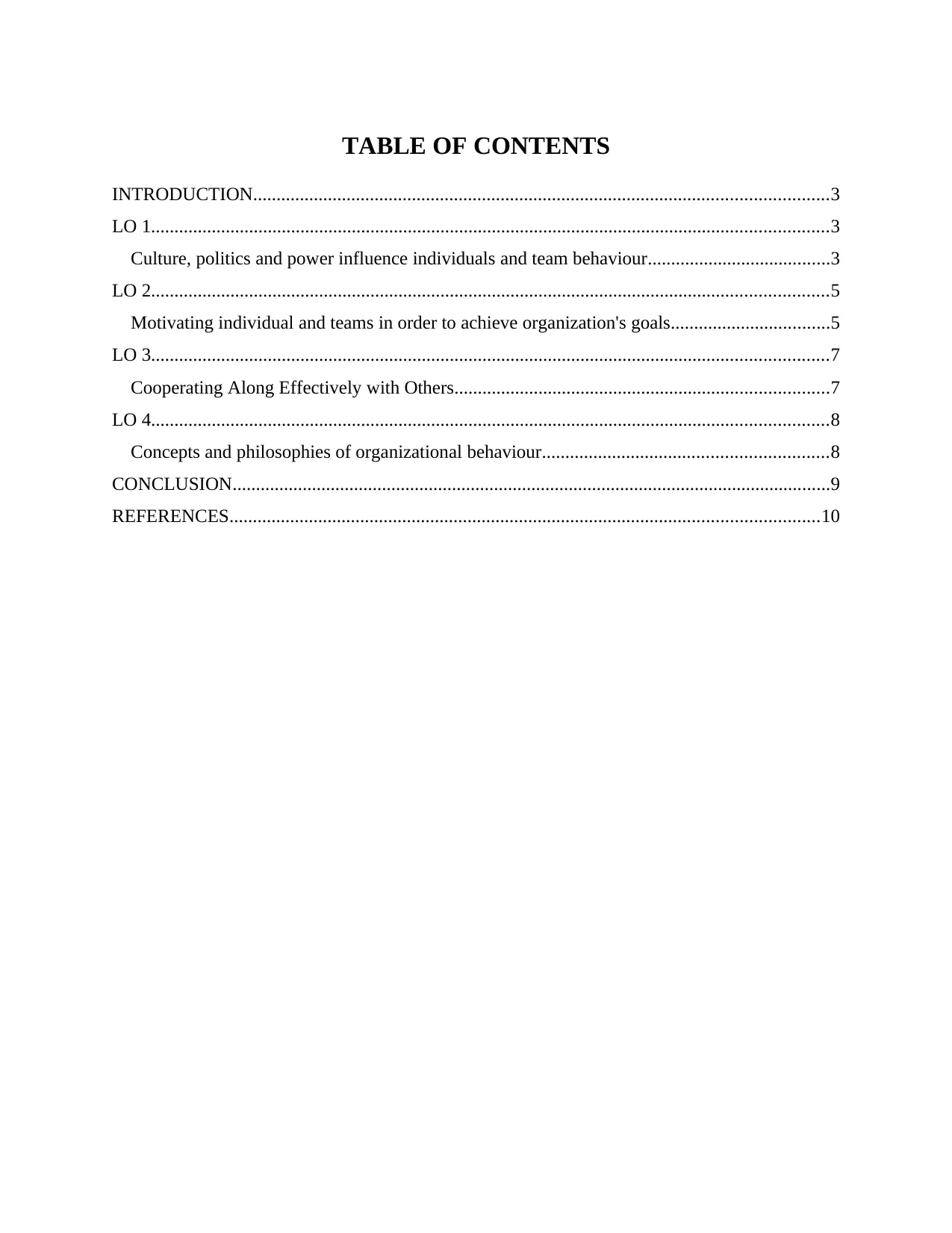
TABLE OF CONTENTS
INTRODUCTION...........................................................................................................................3
LO 1.................................................................................................................................................3
Culture, politics and power influence individuals and team behaviour.......................................3
LO 2.................................................................................................................................................5
Motivating individual and teams in order to achieve organization's goals..................................5
LO 3.................................................................................................................................................7
Cooperating Along Effectively with Others................................................................................7
LO 4.................................................................................................................................................8
Concepts and philosophies of organizational behaviour.............................................................8
CONCLUSION................................................................................................................................9
REFERENCES..............................................................................................................................10
INTRODUCTION...........................................................................................................................3
LO 1.................................................................................................................................................3
Culture, politics and power influence individuals and team behaviour.......................................3
LO 2.................................................................................................................................................5
Motivating individual and teams in order to achieve organization's goals..................................5
LO 3.................................................................................................................................................7
Cooperating Along Effectively with Others................................................................................7
LO 4.................................................................................................................................................8
Concepts and philosophies of organizational behaviour.............................................................8
CONCLUSION................................................................................................................................9
REFERENCES..............................................................................................................................10

INTRODUCTION
Organisational behaviour is the process of evaluating how employees behave and
perform their duties and responsibilities at workplace, which internal and external factors
increase their motivational level and how management of a business can help create a feeling of
strong relationship within its employees and workforce (Gelfand and et.al., 2017). In this report
we will evaluate the effects of organizational behaviour on the organization Sainsbury, a retail
supermarket chain operating in the UK. Having began its operations in 1869, close to 151 years
ago, Sainsbury has had great success in the supermarket sector having captured 16% of the total
market share.
LO 1
Culture, politics and power influence individuals and team behaviour
There are a lot of factors which can influence the working of an organization like culture,
politics and power which can have an influence on the working of the company. It is very
essential for Sainsbury's to have these factors into consideration so that they can have a better
decision-making for the future.
Handy's cultural model
This model was given by Charles Handy's which is a cultural model which was given in
1993. Handy's model is divided into four sub-categories which are role, task, power and person.
This will make the company understand the internal factors of the company so that the
organization can have an effective functioning for themselves so that they can have a better
effectiveness in the market (Safi, Azouri and Saliba, 2018). The further report would discuss the
model in detail.
Power
Power has to be given to the right people in the company so that there is a better
functioning of the organization. Experienced employees must be given the power of achieving
the objectives so that the company can have a profit and attract more customers. This can make
the individuals of the organization be monitored and finish their work and teams to be working
together and power will not be misused.
Role
All the individuals have to be given the right job and according to the skills they have so
that the quality of the company does not fall and the company will be able to have a profit. This
Organisational behaviour is the process of evaluating how employees behave and
perform their duties and responsibilities at workplace, which internal and external factors
increase their motivational level and how management of a business can help create a feeling of
strong relationship within its employees and workforce (Gelfand and et.al., 2017). In this report
we will evaluate the effects of organizational behaviour on the organization Sainsbury, a retail
supermarket chain operating in the UK. Having began its operations in 1869, close to 151 years
ago, Sainsbury has had great success in the supermarket sector having captured 16% of the total
market share.
LO 1
Culture, politics and power influence individuals and team behaviour
There are a lot of factors which can influence the working of an organization like culture,
politics and power which can have an influence on the working of the company. It is very
essential for Sainsbury's to have these factors into consideration so that they can have a better
decision-making for the future.
Handy's cultural model
This model was given by Charles Handy's which is a cultural model which was given in
1993. Handy's model is divided into four sub-categories which are role, task, power and person.
This will make the company understand the internal factors of the company so that the
organization can have an effective functioning for themselves so that they can have a better
effectiveness in the market (Safi, Azouri and Saliba, 2018). The further report would discuss the
model in detail.
Power
Power has to be given to the right people in the company so that there is a better
functioning of the organization. Experienced employees must be given the power of achieving
the objectives so that the company can have a profit and attract more customers. This can make
the individuals of the organization be monitored and finish their work and teams to be working
together and power will not be misused.
Role
All the individuals have to be given the right job and according to the skills they have so
that the quality of the company does not fall and the company will be able to have a profit. This
⊘ This is a preview!⊘
Do you want full access?
Subscribe today to unlock all pages.

Trusted by 1+ million students worldwide

will make the teams also achieve their objectives from time to time which is very essential in
Sainsbury's so that they can have a higher revenue generation.
Task
To have a clarity in the functioning it is very essential for the group members to have a
better delegation of tasks to individuals and groups so that the objectives and the pressure on
everyone can be balanced out.
Person
There has to be experienced and skilled employees hired in the organization so that there
is an exchange of knowledge and skills between the team and individuals so that the organization
can benefit from it.
Influence of politics
Influence of politics is high in individuals and team because of politics which has to be
controlled otherwise the company will not be able to function effectively (Chang and et.al.,
2016). There are positives and negatives of the politics in Sainsbury's since there are a lot of
people who are not giving their best in the company because they find an easier way out to get
their work done in the company which is not making the company actually meet their objectives.
This can make the productivity of Sainsbury's fall in the market and the organization must try to
have a control on this factor otherwise they will not be able to grow in the future.
Hofstede Classification
There are a lot of factors which can have an influence on the working of the company
like cross cultural communication which can be discussed in this model. There are 6 dimensions
which are having an influence on the cultural factor of the company. Power distance is that
Sainsbury's is having the right skilled employees in the company for the task to be completed
which is having a positive impact. Masculinity vs femininity has to be equally treated in the
company so that the organization can have a strong working and the productivity of the company
will increase if this is followed in the company for along run in market. Long term orientation
and short term orientation is present in Sainsbury's which is why they are being able to function
effectively and are having a strong workforce. This is getting a clarity in the work which is
taking place in the company. Individualism vs collectivism both have to be present in Sainsbury's
so that the working of the task can be better and the right skilled employees is given the right
amount of freedom to complete the task without influences. Indulgence vs restraint is there in the
Sainsbury's so that they can have a higher revenue generation.
Task
To have a clarity in the functioning it is very essential for the group members to have a
better delegation of tasks to individuals and groups so that the objectives and the pressure on
everyone can be balanced out.
Person
There has to be experienced and skilled employees hired in the organization so that there
is an exchange of knowledge and skills between the team and individuals so that the organization
can benefit from it.
Influence of politics
Influence of politics is high in individuals and team because of politics which has to be
controlled otherwise the company will not be able to function effectively (Chang and et.al.,
2016). There are positives and negatives of the politics in Sainsbury's since there are a lot of
people who are not giving their best in the company because they find an easier way out to get
their work done in the company which is not making the company actually meet their objectives.
This can make the productivity of Sainsbury's fall in the market and the organization must try to
have a control on this factor otherwise they will not be able to grow in the future.
Hofstede Classification
There are a lot of factors which can have an influence on the working of the company
like cross cultural communication which can be discussed in this model. There are 6 dimensions
which are having an influence on the cultural factor of the company. Power distance is that
Sainsbury's is having the right skilled employees in the company for the task to be completed
which is having a positive impact. Masculinity vs femininity has to be equally treated in the
company so that the organization can have a strong working and the productivity of the company
will increase if this is followed in the company for along run in market. Long term orientation
and short term orientation is present in Sainsbury's which is why they are being able to function
effectively and are having a strong workforce. This is getting a clarity in the work which is
taking place in the company. Individualism vs collectivism both have to be present in Sainsbury's
so that the working of the task can be better and the right skilled employees is given the right
amount of freedom to complete the task without influences. Indulgence vs restraint is there in the
Paraphrase This Document
Need a fresh take? Get an instant paraphrase of this document with our AI Paraphraser
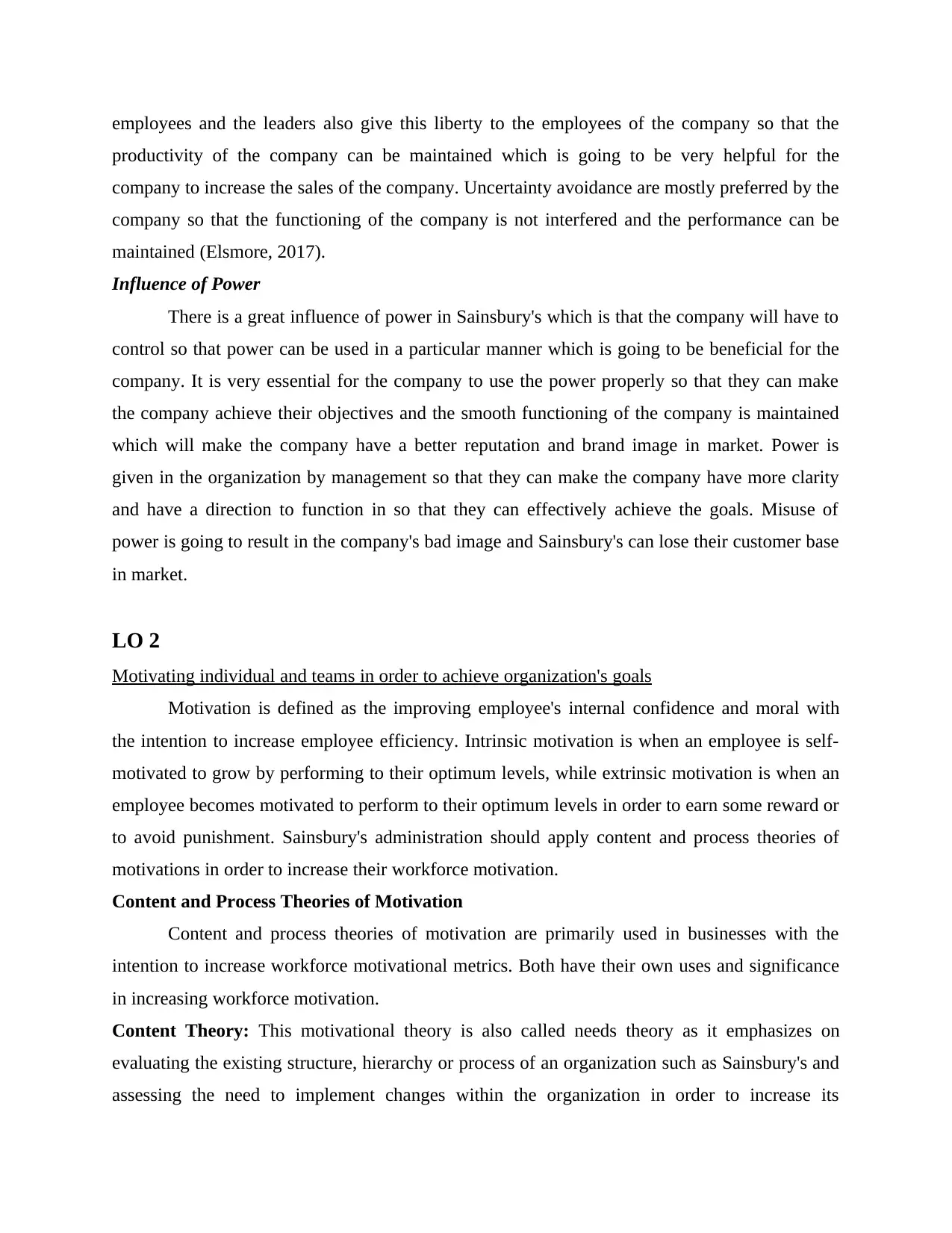
employees and the leaders also give this liberty to the employees of the company so that the
productivity of the company can be maintained which is going to be very helpful for the
company to increase the sales of the company. Uncertainty avoidance are mostly preferred by the
company so that the functioning of the company is not interfered and the performance can be
maintained (Elsmore, 2017).
Influence of Power
There is a great influence of power in Sainsbury's which is that the company will have to
control so that power can be used in a particular manner which is going to be beneficial for the
company. It is very essential for the company to use the power properly so that they can make
the company achieve their objectives and the smooth functioning of the company is maintained
which will make the company have a better reputation and brand image in market. Power is
given in the organization by management so that they can make the company have more clarity
and have a direction to function in so that they can effectively achieve the goals. Misuse of
power is going to result in the company's bad image and Sainsbury's can lose their customer base
in market.
LO 2
Motivating individual and teams in order to achieve organization's goals
Motivation is defined as the improving employee's internal confidence and moral with
the intention to increase employee efficiency. Intrinsic motivation is when an employee is self-
motivated to grow by performing to their optimum levels, while extrinsic motivation is when an
employee becomes motivated to perform to their optimum levels in order to earn some reward or
to avoid punishment. Sainsbury's administration should apply content and process theories of
motivations in order to increase their workforce motivation.
Content and Process Theories of Motivation
Content and process theories of motivation are primarily used in businesses with the
intention to increase workforce motivational metrics. Both have their own uses and significance
in increasing workforce motivation.
Content Theory: This motivational theory is also called needs theory as it emphasizes on
evaluating the existing structure, hierarchy or process of an organization such as Sainsbury's and
assessing the need to implement changes within the organization in order to increase its
productivity of the company can be maintained which is going to be very helpful for the
company to increase the sales of the company. Uncertainty avoidance are mostly preferred by the
company so that the functioning of the company is not interfered and the performance can be
maintained (Elsmore, 2017).
Influence of Power
There is a great influence of power in Sainsbury's which is that the company will have to
control so that power can be used in a particular manner which is going to be beneficial for the
company. It is very essential for the company to use the power properly so that they can make
the company achieve their objectives and the smooth functioning of the company is maintained
which will make the company have a better reputation and brand image in market. Power is
given in the organization by management so that they can make the company have more clarity
and have a direction to function in so that they can effectively achieve the goals. Misuse of
power is going to result in the company's bad image and Sainsbury's can lose their customer base
in market.
LO 2
Motivating individual and teams in order to achieve organization's goals
Motivation is defined as the improving employee's internal confidence and moral with
the intention to increase employee efficiency. Intrinsic motivation is when an employee is self-
motivated to grow by performing to their optimum levels, while extrinsic motivation is when an
employee becomes motivated to perform to their optimum levels in order to earn some reward or
to avoid punishment. Sainsbury's administration should apply content and process theories of
motivations in order to increase their workforce motivation.
Content and Process Theories of Motivation
Content and process theories of motivation are primarily used in businesses with the
intention to increase workforce motivational metrics. Both have their own uses and significance
in increasing workforce motivation.
Content Theory: This motivational theory is also called needs theory as it emphasizes on
evaluating the existing structure, hierarchy or process of an organization such as Sainsbury's and
assessing the need to implement changes within the organization in order to increase its
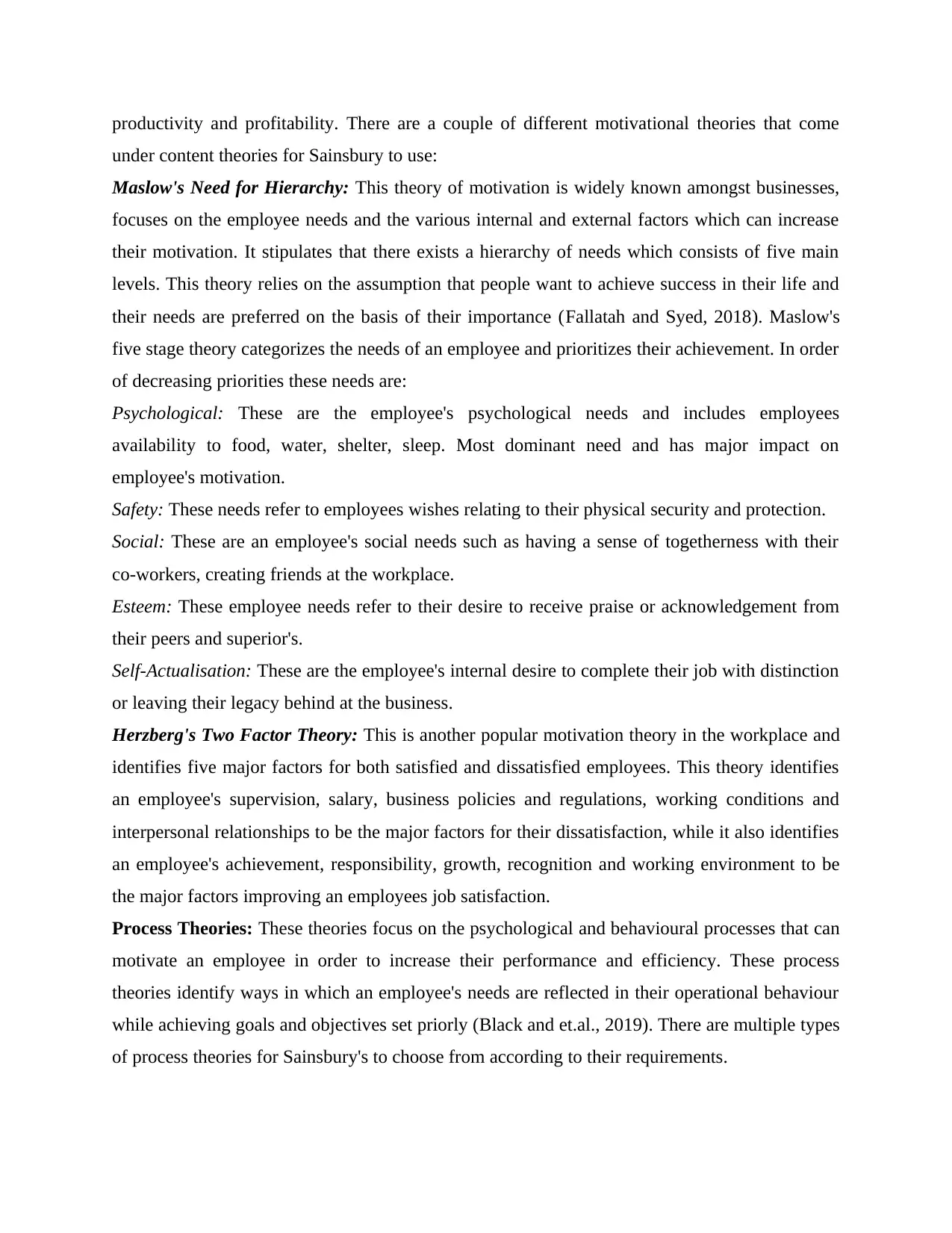
productivity and profitability. There are a couple of different motivational theories that come
under content theories for Sainsbury to use:
Maslow's Need for Hierarchy: This theory of motivation is widely known amongst businesses,
focuses on the employee needs and the various internal and external factors which can increase
their motivation. It stipulates that there exists a hierarchy of needs which consists of five main
levels. This theory relies on the assumption that people want to achieve success in their life and
their needs are preferred on the basis of their importance (Fallatah and Syed, 2018). Maslow's
five stage theory categorizes the needs of an employee and prioritizes their achievement. In order
of decreasing priorities these needs are:
Psychological: These are the employee's psychological needs and includes employees
availability to food, water, shelter, sleep. Most dominant need and has major impact on
employee's motivation.
Safety: These needs refer to employees wishes relating to their physical security and protection.
Social: These are an employee's social needs such as having a sense of togetherness with their
co-workers, creating friends at the workplace.
Esteem: These employee needs refer to their desire to receive praise or acknowledgement from
their peers and superior's.
Self-Actualisation: These are the employee's internal desire to complete their job with distinction
or leaving their legacy behind at the business.
Herzberg's Two Factor Theory: This is another popular motivation theory in the workplace and
identifies five major factors for both satisfied and dissatisfied employees. This theory identifies
an employee's supervision, salary, business policies and regulations, working conditions and
interpersonal relationships to be the major factors for their dissatisfaction, while it also identifies
an employee's achievement, responsibility, growth, recognition and working environment to be
the major factors improving an employees job satisfaction.
Process Theories: These theories focus on the psychological and behavioural processes that can
motivate an employee in order to increase their performance and efficiency. These process
theories identify ways in which an employee's needs are reflected in their operational behaviour
while achieving goals and objectives set priorly (Black and et.al., 2019). There are multiple types
of process theories for Sainsbury's to choose from according to their requirements.
under content theories for Sainsbury to use:
Maslow's Need for Hierarchy: This theory of motivation is widely known amongst businesses,
focuses on the employee needs and the various internal and external factors which can increase
their motivation. It stipulates that there exists a hierarchy of needs which consists of five main
levels. This theory relies on the assumption that people want to achieve success in their life and
their needs are preferred on the basis of their importance (Fallatah and Syed, 2018). Maslow's
five stage theory categorizes the needs of an employee and prioritizes their achievement. In order
of decreasing priorities these needs are:
Psychological: These are the employee's psychological needs and includes employees
availability to food, water, shelter, sleep. Most dominant need and has major impact on
employee's motivation.
Safety: These needs refer to employees wishes relating to their physical security and protection.
Social: These are an employee's social needs such as having a sense of togetherness with their
co-workers, creating friends at the workplace.
Esteem: These employee needs refer to their desire to receive praise or acknowledgement from
their peers and superior's.
Self-Actualisation: These are the employee's internal desire to complete their job with distinction
or leaving their legacy behind at the business.
Herzberg's Two Factor Theory: This is another popular motivation theory in the workplace and
identifies five major factors for both satisfied and dissatisfied employees. This theory identifies
an employee's supervision, salary, business policies and regulations, working conditions and
interpersonal relationships to be the major factors for their dissatisfaction, while it also identifies
an employee's achievement, responsibility, growth, recognition and working environment to be
the major factors improving an employees job satisfaction.
Process Theories: These theories focus on the psychological and behavioural processes that can
motivate an employee in order to increase their performance and efficiency. These process
theories identify ways in which an employee's needs are reflected in their operational behaviour
while achieving goals and objectives set priorly (Black and et.al., 2019). There are multiple types
of process theories for Sainsbury's to choose from according to their requirements.
⊘ This is a preview!⊘
Do you want full access?
Subscribe today to unlock all pages.

Trusted by 1+ million students worldwide
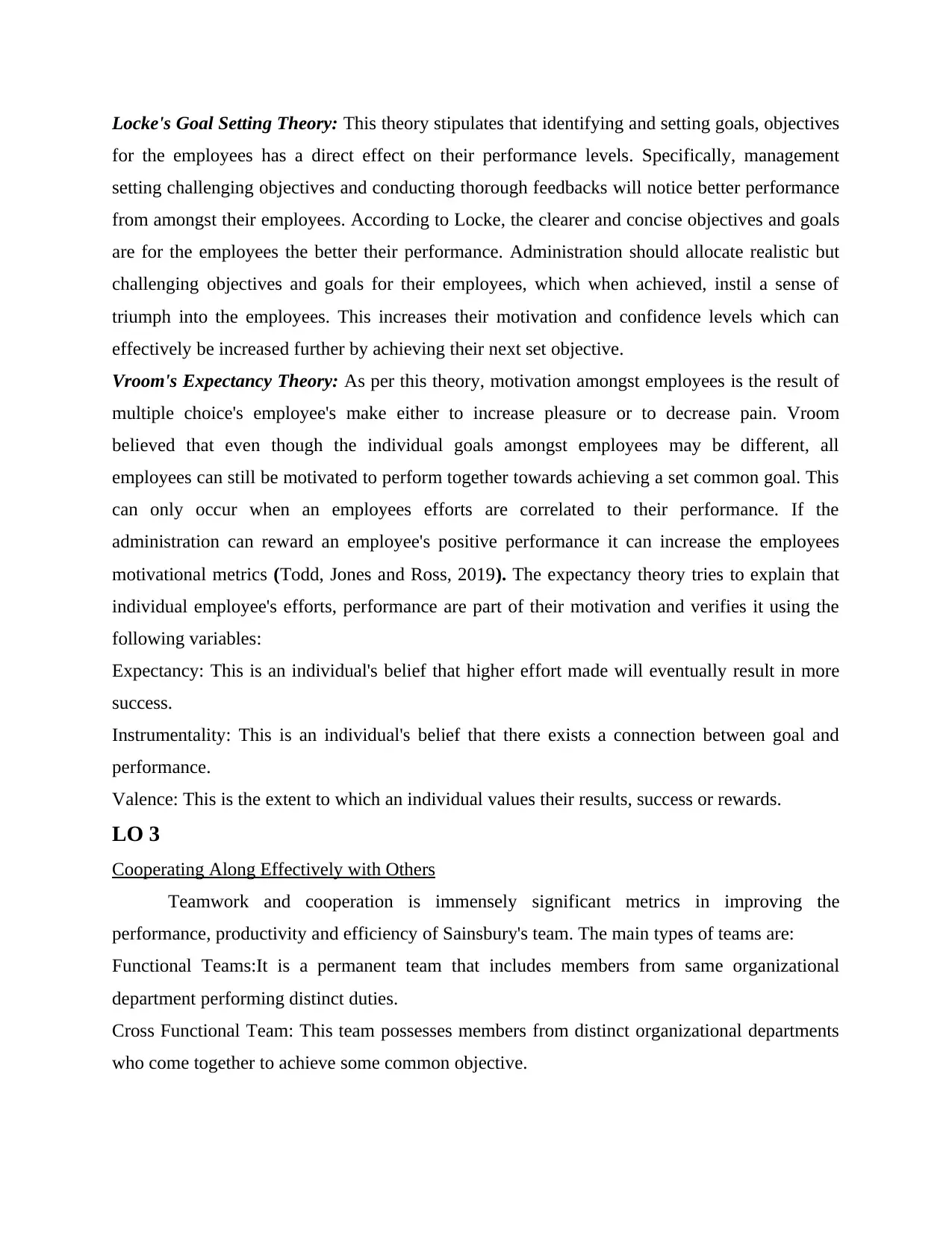
Locke's Goal Setting Theory: This theory stipulates that identifying and setting goals, objectives
for the employees has a direct effect on their performance levels. Specifically, management
setting challenging objectives and conducting thorough feedbacks will notice better performance
from amongst their employees. According to Locke, the clearer and concise objectives and goals
are for the employees the better their performance. Administration should allocate realistic but
challenging objectives and goals for their employees, which when achieved, instil a sense of
triumph into the employees. This increases their motivation and confidence levels which can
effectively be increased further by achieving their next set objective.
Vroom's Expectancy Theory: As per this theory, motivation amongst employees is the result of
multiple choice's employee's make either to increase pleasure or to decrease pain. Vroom
believed that even though the individual goals amongst employees may be different, all
employees can still be motivated to perform together towards achieving a set common goal. This
can only occur when an employees efforts are correlated to their performance. If the
administration can reward an employee's positive performance it can increase the employees
motivational metrics (Todd, Jones and Ross, 2019). The expectancy theory tries to explain that
individual employee's efforts, performance are part of their motivation and verifies it using the
following variables:
Expectancy: This is an individual's belief that higher effort made will eventually result in more
success.
Instrumentality: This is an individual's belief that there exists a connection between goal and
performance.
Valence: This is the extent to which an individual values their results, success or rewards.
LO 3
Cooperating Along Effectively with Others
Teamwork and cooperation is immensely significant metrics in improving the
performance, productivity and efficiency of Sainsbury's team. The main types of teams are:
Functional Teams:It is a permanent team that includes members from same organizational
department performing distinct duties.
Cross Functional Team: This team possesses members from distinct organizational departments
who come together to achieve some common objective.
for the employees has a direct effect on their performance levels. Specifically, management
setting challenging objectives and conducting thorough feedbacks will notice better performance
from amongst their employees. According to Locke, the clearer and concise objectives and goals
are for the employees the better their performance. Administration should allocate realistic but
challenging objectives and goals for their employees, which when achieved, instil a sense of
triumph into the employees. This increases their motivation and confidence levels which can
effectively be increased further by achieving their next set objective.
Vroom's Expectancy Theory: As per this theory, motivation amongst employees is the result of
multiple choice's employee's make either to increase pleasure or to decrease pain. Vroom
believed that even though the individual goals amongst employees may be different, all
employees can still be motivated to perform together towards achieving a set common goal. This
can only occur when an employees efforts are correlated to their performance. If the
administration can reward an employee's positive performance it can increase the employees
motivational metrics (Todd, Jones and Ross, 2019). The expectancy theory tries to explain that
individual employee's efforts, performance are part of their motivation and verifies it using the
following variables:
Expectancy: This is an individual's belief that higher effort made will eventually result in more
success.
Instrumentality: This is an individual's belief that there exists a connection between goal and
performance.
Valence: This is the extent to which an individual values their results, success or rewards.
LO 3
Cooperating Along Effectively with Others
Teamwork and cooperation is immensely significant metrics in improving the
performance, productivity and efficiency of Sainsbury's team. The main types of teams are:
Functional Teams:It is a permanent team that includes members from same organizational
department performing distinct duties.
Cross Functional Team: This team possesses members from distinct organizational departments
who come together to achieve some common objective.
Paraphrase This Document
Need a fresh take? Get an instant paraphrase of this document with our AI Paraphraser

Virtual Team: This team's members aren't in the physical vicinity of one another and have no
face to face interactions between them. People from different countries, time zones, cultures
come together to form a virtual team.
Self-Directed Team: These team members do not have to be brought together by the
management, instead the team forms on its own in order to work towards a common goal.
Because of the advancements in technology, teams can now discuss and interact digitally,
which means a lot of restrictions placed on the type of members to be included into teams is
lifted. Now skilled and experienced individuals can be inducted into a team even if they live in
other countries, time zones and can be called upon to provide their expertise.
As the words group and team is often used interchangeably, it is imperative for Sainsbury
to understand the distinction they offer. A group is a collection of independent individuals with
diverse objectives who are brought together by their shared interests and experiences, while a
team is an interdependent group of individuals, all of whom are share responsibility and work
towards a common objective.
In order to assess the effectiveness of a given team, Sainsbury's administration should
make use of various team development models such as:
Tuckman Model
This model tries to assess team member's behaviours and team development and can be
used for all types of team requirements (Black and et.al., 2019). The model evaluates and
explains various team dynamics within a business and how these can be used to increase the
performance and efficiency of a team. This model includes four main processes which every
team has to experience during their operations called Forming, Storming, Norming and
Performing. These stages describe the journey, experiences, problems and issues generally faced
by teams during operations. Later Tuckman ended up adding a final stage called Adjourning to
his model which describes the last stage of team dynamics in which team has to disband.
Belbin's Model
This model is another effective approach to assessing the relative strengths and
weaknesses of a team and its members and aids in evaluating ways through which team's
performance and efficiency can be improved. The model defines nine distinct team roles that can
predict potential operational success of a team and maintains that a strong team needs diverse
members of distinct characteristics and personalities (Lynch, Lynch and Clemens, 2018). These
face to face interactions between them. People from different countries, time zones, cultures
come together to form a virtual team.
Self-Directed Team: These team members do not have to be brought together by the
management, instead the team forms on its own in order to work towards a common goal.
Because of the advancements in technology, teams can now discuss and interact digitally,
which means a lot of restrictions placed on the type of members to be included into teams is
lifted. Now skilled and experienced individuals can be inducted into a team even if they live in
other countries, time zones and can be called upon to provide their expertise.
As the words group and team is often used interchangeably, it is imperative for Sainsbury
to understand the distinction they offer. A group is a collection of independent individuals with
diverse objectives who are brought together by their shared interests and experiences, while a
team is an interdependent group of individuals, all of whom are share responsibility and work
towards a common objective.
In order to assess the effectiveness of a given team, Sainsbury's administration should
make use of various team development models such as:
Tuckman Model
This model tries to assess team member's behaviours and team development and can be
used for all types of team requirements (Black and et.al., 2019). The model evaluates and
explains various team dynamics within a business and how these can be used to increase the
performance and efficiency of a team. This model includes four main processes which every
team has to experience during their operations called Forming, Storming, Norming and
Performing. These stages describe the journey, experiences, problems and issues generally faced
by teams during operations. Later Tuckman ended up adding a final stage called Adjourning to
his model which describes the last stage of team dynamics in which team has to disband.
Belbin's Model
This model is another effective approach to assessing the relative strengths and
weaknesses of a team and its members and aids in evaluating ways through which team's
performance and efficiency can be improved. The model defines nine distinct team roles that can
predict potential operational success of a team and maintains that a strong team needs diverse
members of distinct characteristics and personalities (Lynch, Lynch and Clemens, 2018). These

nine team roles are: Shaper, Implementer, Completer finisher comprising the action oriented
team roles, Co-ordinator, Team worker and Resource Investigator comprising the people
oriented roles and Plant, Monitor Evaluator and Specialist roles comprising the central team
roles.
In order to develop an effective team Sainsbury's administration needs to resolve
conflicts amongst team members in an efficient and quick manner to not let their personal
conflicts hamper the team's overall performance and productivity.
LO 4
Concepts and philosophies of organizational behaviour
Leadership is a role which is performed by the leaders of the company so that they can
have an effective functioning for themselves and the results of the organization are up to the
standards of the company (Tokay and Eyupoglu, 2018).
Path goal theory
The employees have to be motivated, empowered and satisfied with the work they are
doing in the company so that there is a better functioning of Sainsbury's. This is only possible
when the leaders are motivated and the organization will be able to get a competitive advantage
because of that factor.
Behavioural theory
B. F. Skinner has given a behavioural theory which says there has to be a reward which
has to be provided to the employees and punishments if they are not being able to meet the
expectations of the company. Employees must have motivation and fear in them so that they can
give their personal best in Sainsbury's which will help the organization to achieve their
objectives and aims.
Situational leadership style
There are a lot of situations which come in front of the leaders and the leaders must be
experienced and skilled to take a learning from it and to solve the trouble. There have to be a
smooth functioning within an organization so that Sainsbury's can achieve their objectives and
goals from time to time (Hadi, Abdullah and Atshan, 2019). Leaders of the company are
motivated which is providing the employees with a positive environment to work within. This
factor will lead to customer satisfaction with the products of the company.
team roles, Co-ordinator, Team worker and Resource Investigator comprising the people
oriented roles and Plant, Monitor Evaluator and Specialist roles comprising the central team
roles.
In order to develop an effective team Sainsbury's administration needs to resolve
conflicts amongst team members in an efficient and quick manner to not let their personal
conflicts hamper the team's overall performance and productivity.
LO 4
Concepts and philosophies of organizational behaviour
Leadership is a role which is performed by the leaders of the company so that they can
have an effective functioning for themselves and the results of the organization are up to the
standards of the company (Tokay and Eyupoglu, 2018).
Path goal theory
The employees have to be motivated, empowered and satisfied with the work they are
doing in the company so that there is a better functioning of Sainsbury's. This is only possible
when the leaders are motivated and the organization will be able to get a competitive advantage
because of that factor.
Behavioural theory
B. F. Skinner has given a behavioural theory which says there has to be a reward which
has to be provided to the employees and punishments if they are not being able to meet the
expectations of the company. Employees must have motivation and fear in them so that they can
give their personal best in Sainsbury's which will help the organization to achieve their
objectives and aims.
Situational leadership style
There are a lot of situations which come in front of the leaders and the leaders must be
experienced and skilled to take a learning from it and to solve the trouble. There have to be a
smooth functioning within an organization so that Sainsbury's can achieve their objectives and
goals from time to time (Hadi, Abdullah and Atshan, 2019). Leaders of the company are
motivated which is providing the employees with a positive environment to work within. This
factor will lead to customer satisfaction with the products of the company.
⊘ This is a preview!⊘
Do you want full access?
Subscribe today to unlock all pages.

Trusted by 1+ million students worldwide
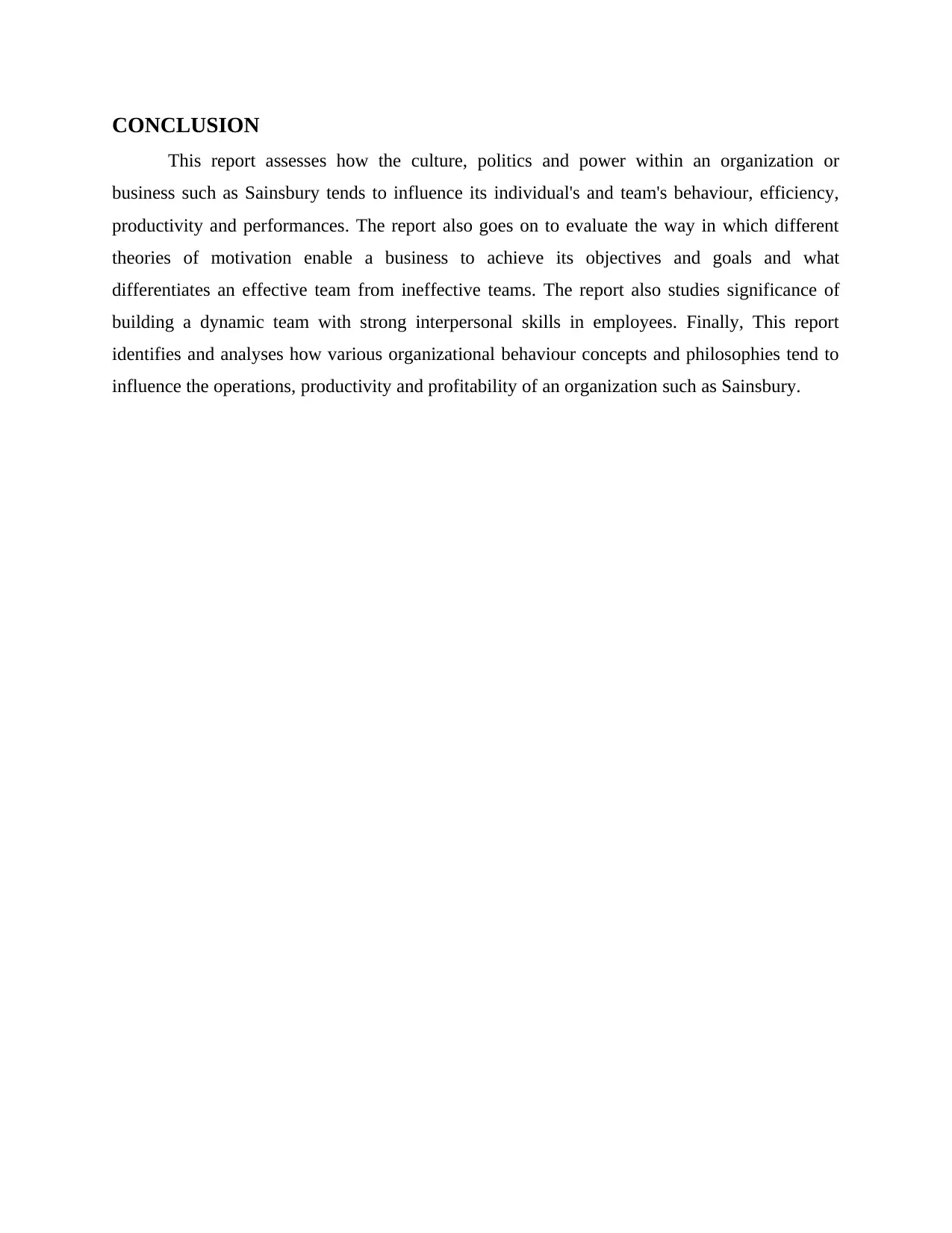
CONCLUSION
This report assesses how the culture, politics and power within an organization or
business such as Sainsbury tends to influence its individual's and team's behaviour, efficiency,
productivity and performances. The report also goes on to evaluate the way in which different
theories of motivation enable a business to achieve its objectives and goals and what
differentiates an effective team from ineffective teams. The report also studies significance of
building a dynamic team with strong interpersonal skills in employees. Finally, This report
identifies and analyses how various organizational behaviour concepts and philosophies tend to
influence the operations, productivity and profitability of an organization such as Sainsbury.
This report assesses how the culture, politics and power within an organization or
business such as Sainsbury tends to influence its individual's and team's behaviour, efficiency,
productivity and performances. The report also goes on to evaluate the way in which different
theories of motivation enable a business to achieve its objectives and goals and what
differentiates an effective team from ineffective teams. The report also studies significance of
building a dynamic team with strong interpersonal skills in employees. Finally, This report
identifies and analyses how various organizational behaviour concepts and philosophies tend to
influence the operations, productivity and profitability of an organization such as Sainsbury.
Paraphrase This Document
Need a fresh take? Get an instant paraphrase of this document with our AI Paraphraser
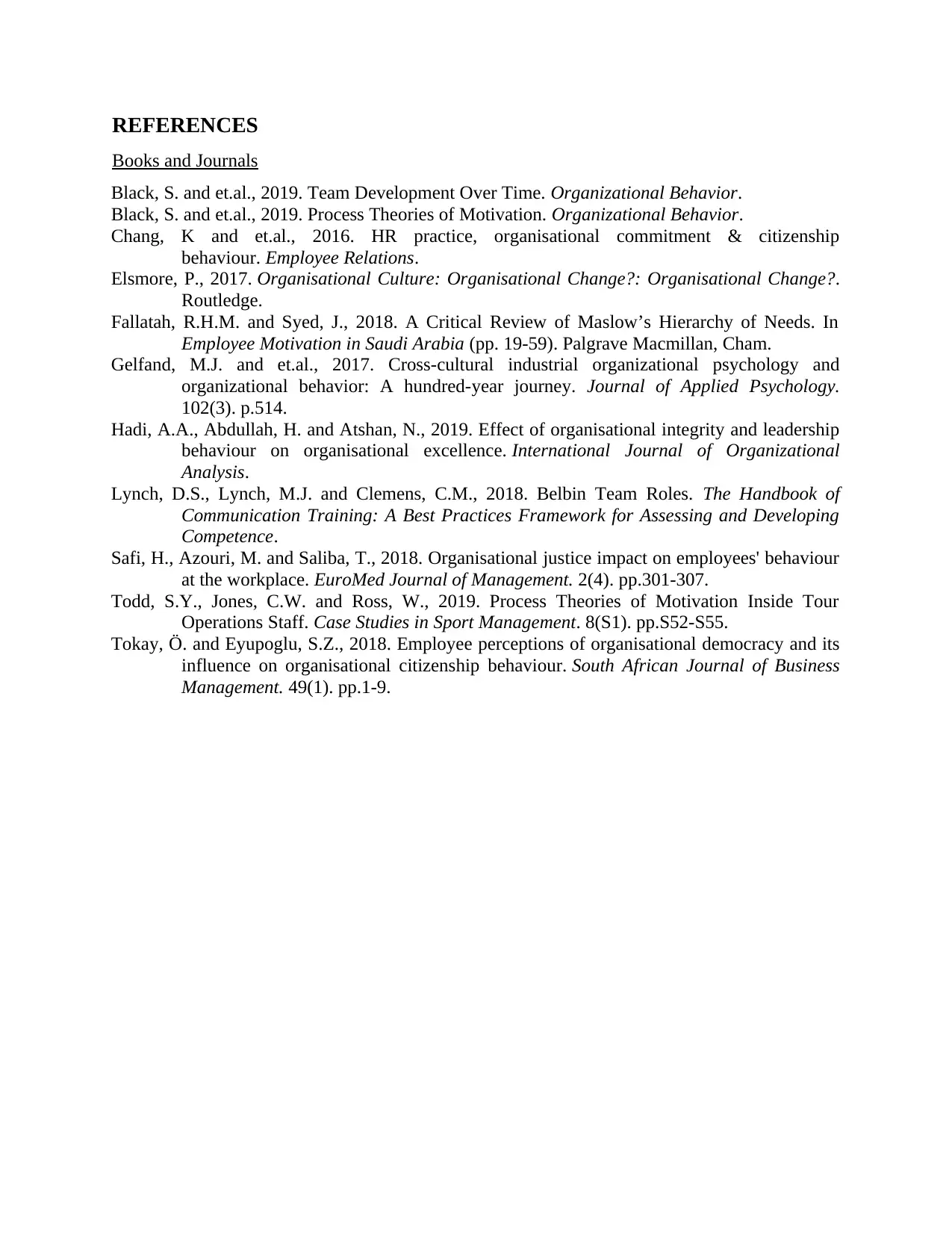
REFERENCES
Books and Journals
Black, S. and et.al., 2019. Team Development Over Time. Organizational Behavior.
Black, S. and et.al., 2019. Process Theories of Motivation. Organizational Behavior.
Chang, K and et.al., 2016. HR practice, organisational commitment & citizenship
behaviour. Employee Relations.
Elsmore, P., 2017. Organisational Culture: Organisational Change?: Organisational Change?.
Routledge.
Fallatah, R.H.M. and Syed, J., 2018. A Critical Review of Maslow’s Hierarchy of Needs. In
Employee Motivation in Saudi Arabia (pp. 19-59). Palgrave Macmillan, Cham.
Gelfand, M.J. and et.al., 2017. Cross-cultural industrial organizational psychology and
organizational behavior: A hundred-year journey. Journal of Applied Psychology.
102(3). p.514.
Hadi, A.A., Abdullah, H. and Atshan, N., 2019. Effect of organisational integrity and leadership
behaviour on organisational excellence. International Journal of Organizational
Analysis.
Lynch, D.S., Lynch, M.J. and Clemens, C.M., 2018. Belbin Team Roles. The Handbook of
Communication Training: A Best Practices Framework for Assessing and Developing
Competence.
Safi, H., Azouri, M. and Saliba, T., 2018. Organisational justice impact on employees' behaviour
at the workplace. EuroMed Journal of Management. 2(4). pp.301-307.
Todd, S.Y., Jones, C.W. and Ross, W., 2019. Process Theories of Motivation Inside Tour
Operations Staff. Case Studies in Sport Management. 8(S1). pp.S52-S55.
Tokay, Ö. and Eyupoglu, S.Z., 2018. Employee perceptions of organisational democracy and its
influence on organisational citizenship behaviour. South African Journal of Business
Management. 49(1). pp.1-9.
Books and Journals
Black, S. and et.al., 2019. Team Development Over Time. Organizational Behavior.
Black, S. and et.al., 2019. Process Theories of Motivation. Organizational Behavior.
Chang, K and et.al., 2016. HR practice, organisational commitment & citizenship
behaviour. Employee Relations.
Elsmore, P., 2017. Organisational Culture: Organisational Change?: Organisational Change?.
Routledge.
Fallatah, R.H.M. and Syed, J., 2018. A Critical Review of Maslow’s Hierarchy of Needs. In
Employee Motivation in Saudi Arabia (pp. 19-59). Palgrave Macmillan, Cham.
Gelfand, M.J. and et.al., 2017. Cross-cultural industrial organizational psychology and
organizational behavior: A hundred-year journey. Journal of Applied Psychology.
102(3). p.514.
Hadi, A.A., Abdullah, H. and Atshan, N., 2019. Effect of organisational integrity and leadership
behaviour on organisational excellence. International Journal of Organizational
Analysis.
Lynch, D.S., Lynch, M.J. and Clemens, C.M., 2018. Belbin Team Roles. The Handbook of
Communication Training: A Best Practices Framework for Assessing and Developing
Competence.
Safi, H., Azouri, M. and Saliba, T., 2018. Organisational justice impact on employees' behaviour
at the workplace. EuroMed Journal of Management. 2(4). pp.301-307.
Todd, S.Y., Jones, C.W. and Ross, W., 2019. Process Theories of Motivation Inside Tour
Operations Staff. Case Studies in Sport Management. 8(S1). pp.S52-S55.
Tokay, Ö. and Eyupoglu, S.Z., 2018. Employee perceptions of organisational democracy and its
influence on organisational citizenship behaviour. South African Journal of Business
Management. 49(1). pp.1-9.
1 out of 11
Related Documents
Your All-in-One AI-Powered Toolkit for Academic Success.
+13062052269
info@desklib.com
Available 24*7 on WhatsApp / Email
![[object Object]](/_next/static/media/star-bottom.7253800d.svg)
Unlock your academic potential
Copyright © 2020–2025 A2Z Services. All Rights Reserved. Developed and managed by ZUCOL.





